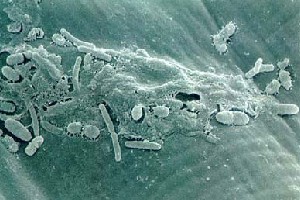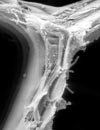Leifsonia xyli
Classification
Higher Order Taxa
Taxonomy: root;cellular organism(Kingdom);Bacteria(Domain);Actinobacteria(Phylum);Actinobacteridae(Class);Actinomycetales(Order);Micrococcineae(Family);Microbacteriaceae(Genus);Leifsonia(Species) [1]
Species
This species comprises two xylema-associated, fastidious, slow growing subspecies, L. xyli subsp. xyli and L. xyli subsp. cynodontis.[2]
Description and significance
Leifsonia xyli is a Gram negative, aerobic, Rod shaped organism, with arrangment in singles or pairs. It has no Endospores or motility and has a host-associated habitat with opt. temperatures for growth at 20-25 degress celcius with a range in the Mesophilic. It is pathogenic to plants and causes Ratoon stunting disease. [3] Leifsonia xyli causes ratoon stunting (growth-hindering) disease of sugarcane and Bermudagrass stunting disease, respectively. Ratoon stunting disease is the most economically important disease of sugarcane resulting in 10-15% loss in crop yields worldwide. The disease is difficult to identify and is transmitted mechanically or through infected seeds. [4]
Genome structure
The findings of the genome structure as, stated in the NCBI database, states,"The single circular chromosome of Leifsonia xyli subsp. xyli CTCB07 was 2.6 Mb in length with a GC content of 68% and 2,044 predicted open reading frames. The analysis also revealed 307 predicted pseudogenes, which is more than any bacterial plant pathogen sequenced to date. Many of these pseudogenes, if functional, would likely be involved in the degradation of plant heteropolysaccharides, uptake of free sugars, and synthesis of amino acids. Although L. xyli subsp. xyli has only been identified colonizing the xylem vessels of sugarcane, the numbers of predicted regulatory genes and sugar transporters are similar to those in free-living organisms." [5] Sequence analysis of the 2,6 Mb circular chromosome of strain CTCB07 revealed the largest number of pseudogenes among the bacterial plant pathogens sequenced to date.[6]
Cell structure and metabolism
Like other Microbacteriaceae, contain unsaturated respiratory menaquinones (MK-10 and MK-11) and an unusual cell wall peptidoglycan with 2,4-diaminobutyric acid (DAB). [7]
Ecology
The disease has been found in most sugarcane growing areas of the world.[8]
Pathology
Pathogenicity has been associated with production of a toxin. Some of the predicted pathogenicity genes appear to have been acquired by lateral transfer and include genes for cellulase, pectinase, wilt-inducing protein, lysozyme, and desaturase. The presence of the latter may contribute to stunting, since it is likely involved in the synthesis of abscisic acid, a hormone that arrests growth. Our findings are consistent with the nutritionally fastidious behavior exhibited by L. xyli subsp. xyli and suggest an ongoing adaptation to the restricted ecological niche it inhabits."[9]


